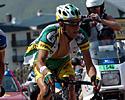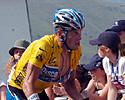
Recently on Cyclingnews.com |
|
|
View from the lab - Ric Stern's Tour de France sports science
British ABCC coach Ric Stern (www.cyclecoach.com) is a regular contributor to Cyclingnews' Form & Fitness section along with being a full time coach. Still an active rider when time allows, Ric will be providing a physiological insight into the challenges that face the riders in the Tour.
July 17, 2005: The Tour's biggest day
An horrendous route greeted the riders for stage 15, with six big climbs for the riders to 'enjoy'! After a gently uphill route for the first 70 or so km, the rest of the route profile looked like a set of shark's teeth. Probably the only people who enjoyed today's stage were the massive crowds on the roadside, and those watching on TV.

|
The last couple of days I've been talking about fatigue (as well as other issues). We often see reports that this or that rider is feeling very tired. Robbie McEwen, as well as Cadel Evans has voiced this on several occasions and then of course there are other issues, such as illness. There have been quite a few reports that my near neighbour Magnus Backstedt isn't feeling too well - I hope he feels better soon.
However, we tend to see less discussion on the fatigue front from the top five GC riders - this is for obvious reasons (no need to tell your rivals that you're suffering; try to bluff your way through it). I therefore thought it might be interesting to see how the big GC riders compared in terms of estimated power output with stage 15 and the previous number crunching day of stage 10.
Additionally, people have contacted me and been interested to see how they would compare if they were riding the Tour de France and what they'd do on such a stage.

|
It's important to bear in mind that I am having to estimate a lot of figures, as certain data isn't (easily) available - for example, air density, the frontal area and drag of a rider (known as coefficient of aero drag - CdA), their actual mass (they could likely weigh less than normal due to losing a few kg in sweat etc), the actual mass of their bike, the mass of all the bits and pieces they have with them (e.g., clothing, helmet, shoes, energy bars, gels, drinks, and the radio/earpieces). I'm just doing these data for fun, if you really wanted to know the exact figures you'd have to collect some SRM data or Power Tap data from the top riders!
The reason I use data for mountain sections is two-fold. Firstly, the slower speeds on the climbs minimises the importance of the variables that we don't know, such as air temperature and density, the CdA of the riders and their masses, etc. The slower you are going the less these factors are important, as gravity is the dominant force that must be overcome. Secondly, people generally want to know how they would compare on a mountain stage - how much time, if any, would they lose to the pros?

|
Back on stage 10, I suggested that Lance Armstrong required about 453W to ride up the Courchevel climb in about 53 minutes. Jan Ullrich, who was approximately two minutes slower, required an estimated power output of 431W.
Back to stage 15, and it appears that Lance and Ivan Basso climbed the 10.3 km to Pla d'Adet (average grade of 8.3 %) in 29 minutes. That's an average velocity of 21.3 km/hr. Jan Ullrich came up 1 minute 24 seconds behind (30.5 minutes) for an average velocity of 20.3 km/hr.
With the limited amount of data, it would appear that Lance averaged 469W to Pla d'Adet. Using the same assumptions, Jan would have averaged 443W up the climb.
For both riders this is an increase of around 3% over the figures from stage 10. So, why are the figures higher when we are so much further into the Tour? Simply, it could be that somewhere I have miscalculated (either underestimated the time taken to climb up Pla d'Adet), or incorrectly assumed some other data. Of course the other option is simply that they rode harder on this climb. As intensity is inversely related to duration, and as this climb was shorter (around 30 minutes compared to around 53 minutes) it's certainly possible that the Armstrong, and Ullrich could have ridden harder and generated more power.

|
It's difficult to suggest exactly how an amateur racer or a sportif rider would do in an actual stage of the Tour de France. Certainly, having myself ridden some of the stages of previous Tours, I know from first hand experience that it's extremely difficult. The actual distance - never mind the climbs - has left me feeling fatigued, and then the intense heat, the climbs, and even the descents can leave you very tired.
The actual average intensity (power output) is likely not dissimilar to your average road race that many people take part in - after all average speed is often similar between amateur racers and pros. However, there are several fundamental differences, being:
1) Pro races are generally much longer than amateur - so a similar power is
sustained for much greater periods of time.
2) They can often start easy (so a break can establish itself) and then finish
off at a horrendous effort.
3) Your average amateur road race doesn't traverse a huge mountain range like
the Pyrenees.
Okay, so a good 3rd category racer could have a maximal aerobic power of 385W, with a mass of 70kg, and they may be able to sustain 280W in a 1-hour TT. So where would they have arrived on the Pla d'Adet? I'll use the same assumptions as before, and remember these are just ballpark estimates!
Up the 10.3km long climb, I estimate that such a rider with that power will climb the Pla d'Adet at a velocity of 14.2 km/hr, which would take them 43.5 minutes, or approximately 14 or so minutes behind Lance and Ivan. Additionally, you should realise that this is just on the one climb and that there was another 195.2 km on the stage, with another five major climbs! On the other climbs it's possible that the amateur racer would lose similar amounts of time, as well as losing time on the flat sections and on the descents to! It's quite possible that the amateur cyclist could be a couple of hours behind at the end of the stage! Of course a trip to next years Etape may help give you a better idea.
2005 entries - the Tour de France
- July 28 - Stage 21 - What it takes
- July 23 - Stage 20 - Getting the TT right - and wrong
- July 22 - Stage 19 - The perfect break
- July 21 - Stage 18 - High intensity and fatigue
- July 19 - Stage 16 - Maintaining an attack
- July 17 - Stage 15 - Tour's biggest day
- July 16 - Stage 14 - Attacks keep coming
- July 15 - Stage 13 - Positive thoughts
- July 14 - Stage 12 - Hot, hot, hot!
- July 13 - Stage 11 - Big efforts uphill
- July 12 - Stage 10 - Number crunching
- July 7 - Stage 6: The dynamics of a breakaway
- July 6 - Stage 5: Coming back after a TT
- July 5 - The TTT - Man, machine and team
Previous Cyclingnews features by Ric Stern
- Winter Training
- Weight training and cycling - The Great Debate
- Power zone training - How to set training levels with a power meter
- Ric Stern also answers Cyclingnews readers' questions in our Form & Fitness Q&A section

